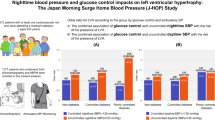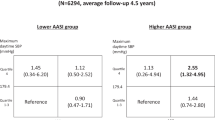Abstract
The objective of this study was to analyse the relationship between the ambulatory blood pressure (ABP) measurement and plasma adiponectin levels in a population-based cohort. Non-hypertensive, non-diabetics from the Oulu Project Elucidating Risk of Atherosclerosis cohort aged 40–60 years with ABP measurement available in 226 men and 236 women were analysed. ABP was recorded using the fully automatic SpaceLabs 90207 oscillometric unit. Plasma adiponectin concentrations were assayed using the enzyme-linked immunosorbent assay method. Without adjustment the highest plasma adiponectin tertile was associated with the lowest ABP and office BP measurements (P from 0.025 to P<0.001, respectively). Only the association of plasma adiponectin concentration with systolic ABP was independent of other conventional risk factors (age, body mass index (BMI), waist, gender, insulin sensitivity index, smoking and alcohol consumption) for hypertension (P=0.017). No association was observed between systolic dipping pattern and adiponectin level. The plasma high adiponectin concentration is independently associated with low daytime systolic ABP value. The mechanisms may include effects on endothelial function and the sympathetic nervous system.
This is a preview of subscription content, access via your institution
Access options
Subscribe to this journal
Receive 12 digital issues and online access to articles
$119.00 per year
only $9.92 per issue
Buy this article
- Purchase on Springer Link
- Instant access to full article PDF
Prices may be subject to local taxes which are calculated during checkout

Similar content being viewed by others
References
Matsuzawa Y . Adiponectin: identification, physiology and clinical relevance in metabolic and vascular disease. Atheroscler Suppl 2005; 6: 7–14.
Weyer C, Funahashi T, Tanaka S, Hotta K, Matsuzawa Y, Pratley RE et al. Hypoadiponectinemia in obesity and type 2 diabetes: close association with insulin resistance and hyperinsulinemia. J Clin Endocrinol Metab 2001; 86: 1930–1935.
Shimabukuro M, Higa N, Asahi T, Oshiro Y, Takasu N, Tagawa T et al. Hypoadiponectinemia is closely linked to endothelial dysfunction in man. J Clin Endocrinol Metab 2003; 88: 3236–3240.
Kumada M, Kihara S, Sumitsuji S, Kawamoto T, Matsumoto S, Ouchi N et al. Association of hypoadiponectinemia with coronary artery disease in men. Arterioscler Thromb Vasc Biol 2003; 23: 85–89.
Guerre-Millo M . Adiponectin: an update (review). Diabetes Metab 2008; 34: 12–18.
Pischon T, Girman CJ, Hotamisligil GS, Rifai N, Hu FB, Rimm EB . Plasma adiponectin levels and risk of myocardial infarction in men. JAMA 2004; 291: 1730–1737.
Santaniemi M, Kesäniemi YA, Ukkola O . Low plasma adiponectin concentration is an indicator of the metabolic syndrome. Eur J Endocrinol 2006; 155: 745–750.
Cesari M, Pessina A, Zanchetta M, De Toni R, Avogaro A, Pedon L et al. Low plasma adiponectin is associated with coronary artery disease but not with hypertension in high-risk nondiabetic patients. J Intern Med 2006; 260: 474–483.
Chow W, Cheung B, Tso A, Xu A, Wat N, Fong C et al. Hypoadiponectinemia as a predictor for the development of hypertension: a 5-year prospective study. Hypertension 2007; 49: 1455–1461.
Otsuka F, Sugiyama S, Kojima S, Maruyoshi H, Funahashi T, Sakamoto T et al. Hypoadiponectinemia is associated with impaired glucose tolerance and coronary artery disease in non-diabetic men. Circ J 2007; 71: 1703–1709.
Tsioufis C, Dimitriadis K, Selima M, Thomopoulos C, Mihas C, Skiadas I et al. Low-grade inflammation and hypoadiponectinaemia have an additive detrimental effect on aortic stiffness in essential hypertensive patients. Eur Heart J 2007; 28: 1162–1169.
Sung S, Chuang S, Sheu W, Lee W, Chu P, Chen C . Adiponectin, but not leptin or high-sensitivity C-reactive protein, is associated with blood pressure independently of general and abdominal adiposity. Hypertens Res 2008; 31: 633–640.
Kazumi T, Kawaguchi A, Sakai K, Hirano T, Yoshino G . Young men with high-normal blood pressure have lower serum adiponectin, smaller LDL size, and higher elevated heart rate than those with optimal blood pressure. Diabetes Care 2002; 16: 72–75.
Huang K, Chen C, Chuang L, Ho S, Tai T, Yang W . Plasma adiponectin levels and blood pressures in nondiabetic adolescent females. J Clin Endocrinol Metab 2003; 88: 4130–4134.
Imai Y, Satoh H, Nagai K, Sakuma M, Sakuma H, Minami N et al. Characteristics of a community-based distribution of home blood pressure in Ohasama in northern Japan. J Hypertens 1993; 11 (12): 1441–1449.
Imai Y, Ohkubo T . Ambulatory blood pressure normality: experience in the Ohasama study. Blood Press Monit 1998; 3 (3): 185–188.
Verdecchia P . Ambulatory blood pressure: current evidence and clinical implications. Hypertension 2000; 35: 844–851.
O'Brien E, Sheridan J, O'Malley K . Dippers and non-dippers. Lancet 1988; 2: 397.
Verdecchia P, Schillaci G, Guerrieri M, Gatteschi C, Benemio G, Boldrini F et al. Circadian blood pressure changes and left ventricular hypertrophy in essential hypertension. Circulation 1990; 81: 528–536.
Verdecchia P, Schillaci G, Zampi I, Gatteschi C, Battistelli M, Bartocchini C et al. Blunted nocturnal fall in blood pressure in hypertensive women with future cardiovascular morbid events. Circulation 1993; 88: 986–992.
Timio M, Venanzi S, Lolli S, Lippi C, Verdura E, Guerrini E et al. Daytime blood pressure and progression of renal insufficiency. High Blood Pressure Cardiovasc Prev 1994; 3: 39–44.
Fagard RH, Staessen JA, Thijs L . The relationships between left ventricular mass and daytime and daytime blood pressure: a meta-analysis of comparative studies. J Hypertens 1995; 13: 823–829.
Mancia G, Parati G . Ambulatory blood pressure monitoring and organ damage. Hypertension 2000; 36: 894–900.
Pickering TG, Shimbo D, Haas D . Ambulatory blood-pressure monitoring. N Engl J Med 2006; 354 (22): 2368–2374.
Tsioufis C, Antoniadis D, Stefanadis C, Tzioumis K, Pitsavos C, Kallikazaros I et al. Relationships between new risk factors and circadian blood pressure variation in untreated subjects with essential hypertension. Am J Hypertens 2002; 15 (7 Pt 1): 600–604.
Della Mea P, Lupia M, Bandolin V, Guzzon S, Sonino N, Vettor R et al. Adiponectin, insulin resistance, and left ventricular structure in dipper and non-dipper essential hypertensive patients. Am J Hypertens 2005; 18 (1): 30–35.
Rantala AO, Kauma H, Lilja M, Savolainen MJ, Reunanen A, Kesäniemi YA . Prevalence of the metabolic syndrome in drug-treated hypertensive patients and control subjects. J Intern Med 1999; 245 (2): 163–174.
Kauma H, Savolainen MJ, Heikkilä R, Rantala AO, Lilja M, Reunanen A et al. Sex difference in the regulation of plasma high density lipoprotein cholesterol by genetic and environmental factors. Hum Genet 1996; 97 (2): 156–162.
Pöykkö SM, Ukkola O, Kauma H, Kellokoski E, Hörkkö S, Kesäniemi YA . The negative association between plasma ghrelin and IGF-I is modified by obesity, insulin resistance and type 2 diabetes. Diabetologia 2005; 48 (2): 309–316.
Huikuri HV, Ylitalo A, Pikkujämsä SM, Ikäheimo MJ, Airaksinen KE, Rantala AO et al. Heart rate variability in systemic hypertension. Am J Cardiol 1996; 77 (12): 1073–1077.
O'Brien E, Coats A, Owens P, Petrie J, Padfield P, Littler WA et al. Use and, interpretation of ambulatory blood pressure monitoring: recommendations of the British Hypertension Society. BMJ 2000; 320: 1128–1134.
Ylitalo A . Cardiovascular autonomic regulation in systemic hypertension. Acta Universitatis Ouluensis Medica, D 519 1999: 37 ISBN 951-42-5211-X. ISSN 0355-3221.
Matsuda M, Shimomura I, Sata M, Arita Y, Nishida M, Maeda N et al. Role of adiponectin in preventing vascular stenosis: the missing link of adipo-vascular axis. J Biol Chem 2002; 277 (40): 37487–37491.
Hopkins TA, Ouchi N, Shibata R, Walsh K . Adiponectin actions in the cardiovascular system. Cardiovasc Res 2007; 74 (1): 11–18.
Zhu W, Cheng KY, Vanhoutte PM, Lam KS, Xu A . Vascular effects of adiponectin: molecular mechanisms and potential therapeutic intervention. Clin Sci 2008; 114: 361–374.
Imai J, Katagiri H, Yamada T, Ishigaki Y, Ogihara T, Uno K et al. Cold exposure suppresses serum adiponectin levels through sympathetic nerve activation in mice. Obesity (Silver Spring) 2006; 14: 1132–1141.
Wang ZV, Scherer PE . Adiponectin, cardiovascular function, and hypertension. Hypertension 2008; 51 (1): 8–14.
Strandberg TE, Pitkälä K . What is the most important component of blood pressure: systolic, diastolic or pulse pressure? Curr Opin Nephrol Hypertens 2003; 12 (3): 293–297.
Lam KS, Xu A . Adiponectin: protection of the endothelium. Curr Diab Rep 2005; 5: 254–259.
Arita Y, Kihara S, Ouchi N, Takahashi M, Maeda K, Miyagawa J et al. Paradoxical decrease of an adipose-specific protein, adiponectin, in obesity. Biochem Biophys Res Commun 1999; 257: 79–83.
Acknowledgements
This study was supported by the Medical Council of the Academy of Finland and the Finnish Foundation for Cardiovascular Research. We acknowledge the excellent technical assistance of Ms Helena Kalliokoski, Ms Saija Kortetjärvi, Ms Sirpa Rannikko and Ms Liisa Mannermaa.
Author information
Authors and Affiliations
Corresponding author
Ethics declarations
Competing interests
The authors declare no conflict of interest.
Rights and permissions
About this article
Cite this article
Vasunta, R., Kesäniemi, Y. & Ukkola, O. Plasma adiponectin concentration is associated with ambulatory daytime systolic blood pressure but not with the dipping status. J Hum Hypertens 24, 545–551 (2010). https://doi.org/10.1038/jhh.2009.98
Received:
Revised:
Accepted:
Published:
Issue Date:
DOI: https://doi.org/10.1038/jhh.2009.98
Keywords
This article is cited by
-
Sympathetic nervous system in obesity-related hypertension: mechanisms and clinical implications
Hypertension Research (2012)
-
Ghrelin and its promoter variant associated with cardiac hypertrophy
Journal of Human Hypertension (2012)
-
Common variation in the adiponectin gene has an effect on systolic blood pressure
Journal of Human Hypertension (2011)



